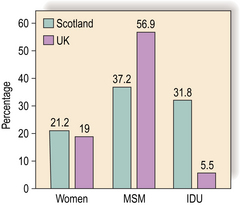Chapter 54 HIV/AIDS
Human immunodeficiency virus (HIV) appeared at a time when it was widely believed that science had brought infectious diseases under control, and it seemed that all of a sudden a new incurable disease presented itself. Until recently it was only possible to treat some of the secondary effects of HIV and acquired immune deficiency syndrome (AIDS – the disease stage of most infected people) and since the infection is currently not curable, the main remedy still lies in prevention. Since the virus can be transmitted in different ways (Box 1), prevention requires targeting different types of behaviour.
Although HIV is widespread (40 million cases were reported worldwide by 2006), it is clear that the infection is not equally spread amongst members of society or between societies. Even within the UK (Fig. 1), we see great differences in the proportion of people infected through sexual intercourse between men and intravenous drug users (IDU). The figure for women as a percentage of the total number of people diagnosed with AIDS differs considerably between Scotland and the UK as a whole (Fig. 1). The proportion of IDU among the people diagnosed with AIDS in Scotland (31.8%) is six times higher than in the UK (5.5%). Thus certain groups of people have a far higher infection rate than others, depending on different parts of the country.

(from HPS eWeekly Report 18 April 2007: http://www.hps.scot.nhs.uk/ewr/index.aspx, with permission).
The disease has distinct social aspects. At a social level it involves several taboos, such as sex, drugs, and death and dying; consequently it is heavily stigmatized. Secondly, at a personal level, the acceptance of being diagnosed as HIV-positive can be very difficult. People can feel isolated, shocked, frightened, panicked and/or guilty, profess denial and become depressed, but some also display a sense of coming to terms with themselves, and even acceptance. Such emotions are understandable, as people have to accept that they have a long-term illness (in high- and middle-income countries) and/or become more aware of their own mortality (in many low-income countries). Treatment using antiretroviral drugs is expensive, which is particularly a problem in sub-Saharan Africa (see pp. 158–159).
Double stigma
HIV has what is called a double stigma attached. Stigma refers to the identification and recognition of a bad or negative characteristic in a person or group of people and the treatment of them with less respect or worth than they deserve due to this characteristic (see pp. 60–61
Stay updated, free articles. Join our Telegram channel

Full access? Get Clinical Tree







